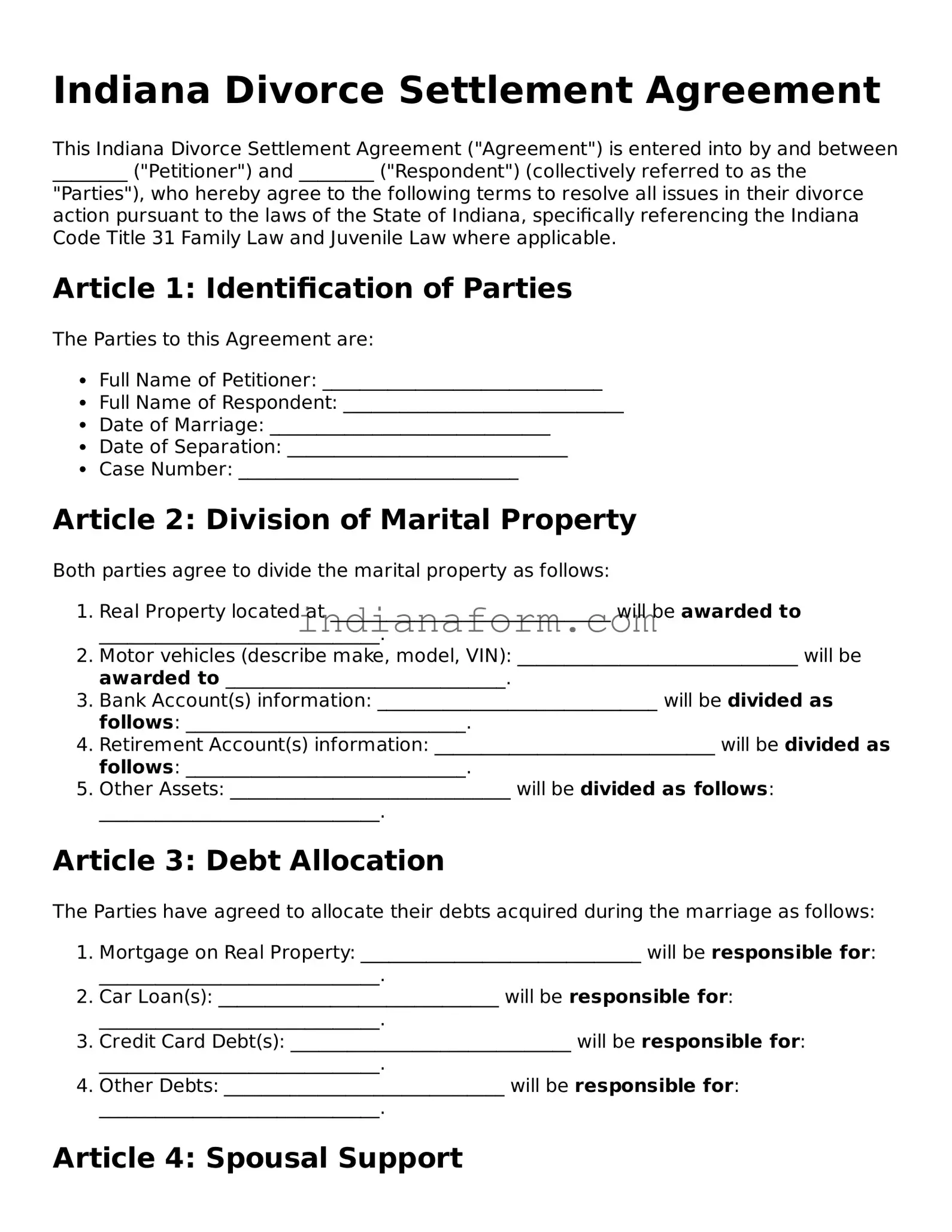Indiana Divorce Settlement Agreement
This Indiana Divorce Settlement Agreement ("Agreement") is entered into by and between ________ ("Petitioner") and ________ ("Respondent") (collectively referred to as the "Parties"), who hereby agree to the following terms to resolve all issues in their divorce action pursuant to the laws of the State of Indiana, specifically referencing the Indiana Code Title 31 Family Law and Juvenile Law where applicable.
Article 1: Identification of Parties
The Parties to this Agreement are:
- Full Name of Petitioner: ______________________________
- Full Name of Respondent: ______________________________
- Date of Marriage: ______________________________
- Date of Separation: ______________________________
- Case Number: ______________________________
Article 2: Division of Marital Property
Both parties agree to divide the marital property as follows:
- Real Property located at ______________________________ will be awarded to ______________________________.
- Motor vehicles (describe make, model, VIN): ______________________________ will be awarded to ______________________________.
- Bank Account(s) information: ______________________________ will be divided as follows: ______________________________.
- Retirement Account(s) information: ______________________________ will be divided as follows: ______________________________.
- Other Assets: ______________________________ will be divided as follows: ______________________________.
Article 3: Debt Allocation
The Parties have agreed to allocate their debts acquired during the marriage as follows:
- Mortgage on Real Property: ______________________________ will be responsible for: ______________________________.
- Car Loan(s): ______________________________ will be responsible for: ______________________________.
- Credit Card Debt(s): ______________________________ will be responsible for: ______________________________.
- Other Debts: ______________________________ will be responsible for: ______________________________.
Article 4: Spousal Support
Regarding spousal support, the Parties agree that:
- ______________________________ (Petitioner/Respondent) will pay to ______________________________ (Petitioner/Respondent), the sum of $________________ per month for a period of __________________.
- Both Parties agree that no spousal support shall be paid.
Article 5: Child Custody, Support, and Parenting Time
If the Parties have minor children, they agree to the following:
- Primary physical custody of the child(ren) will be awarded to ______________________________.
- Both Parties will share legal custody of the child(ren).
- The non-custodial parent will have parenting time in accordance with the Indiana Parenting Time Guidelines.
- Child support will be paid by ______________________________ in the amount of $________________ per month, in accordance with the Indiana Child Support Guidelines.
Article 6: Final Provisions
This Agreement is the entire understanding between the Parties and replaces any prior agreements between them. This Agreement may only be amended in writing and signed by both Parties. The Parties hereby declare that they have sought independent legal advice or have waived their right to do so voluntarily.
Agreed to this _____ day of _______________, 20____.
Signature of Petitioner: ______________________________
Signature of Respondent: ______________________________
Date: ______________________________
